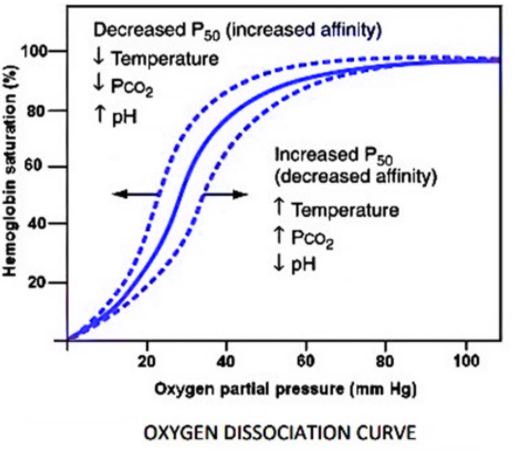
The decrease in the pH of the blood it will decreases :
(a) The rate of heartbeat
(b) The blood supply to the brain
(c) The affinity of hemoglobin with oxygen
(d) Release bicarbonate ions by the liver
Answer
527.1k+ views
Hint: It alludes to the perception that will increment inside the carbon dioxide partial pressure of blood or diminishes in blood pH end in a lower affinity. This manifests as a right-ward shift within the gas-Hemoglobin Dissociation Curve delineated in Oxygen Transport.
Complete answer:
A lower pH within the blood will increase dioxide concentration that successively, is implicational an additional active tissue that needs additional gas. In line with the nuclear physicists, the lower pH can cause Hb to deliver additional gas. This manifests as a right-ward shift within the Oxygen-Hemoglobin Dissociation Curve delineated in gas transport and yields increased unloading of gas by Hb.
Decreases in blood pH, which means exaggerated ${H^+}$ concentration, square measure doubtless the direct reason behind lower Hb affinity for gas. Specifically, the association of ${H^+}$ ions with the amino acids of Hb seems to scale back hemoglobin's affinity for gas. As a result of changes within the dioxide partial pressure will modify blood pH, exaggerated partial pressures of carbon dioxide may end in right-ward shifts of the oxygen-hemoglobin dissociation curve. The link between dioxide partial pressure and blood pH is mediated by carbonic anhydrase that converts carbon dioxide to carbonic acid that successively releases a free proton, reducing the native pH of the blood.
So the correct answer is ‘Decreases the affinity of Hb with oxygen’.
Note:
The nuclear physicist impact permits for increased unloading of gas in metabolically active peripheral tissues like physical exercise musculus. exaggerated musculus activity ends up in nativized will increase within the partial pressure of dioxide that successively reduces the local blood pH. attributable to the nuclear physicist impact, this ends up in increased unloading of certain gas by Hb passing through the metabolically active tissue and so improves gas delivery. significantly, the nuclear physicist impact enhances gas delivery proportionately to the metabolic activity of the tissue. As additional metabolism takes place, the dioxide partial pressure will increase so inflicting larger reductions in native pH and successively permitting bigger gas unloading. This can be very true in physical exercise of skeletal muscles which can additionally unharness the carboxylic acid that additionally reduces native blood pH and so enhances the nuclear physicist impact.

Complete answer:
A lower pH within the blood will increase dioxide concentration that successively, is implicational an additional active tissue that needs additional gas. In line with the nuclear physicists, the lower pH can cause Hb to deliver additional gas. This manifests as a right-ward shift within the Oxygen-Hemoglobin Dissociation Curve delineated in gas transport and yields increased unloading of gas by Hb.
Decreases in blood pH, which means exaggerated ${H^+}$ concentration, square measure doubtless the direct reason behind lower Hb affinity for gas. Specifically, the association of ${H^+}$ ions with the amino acids of Hb seems to scale back hemoglobin's affinity for gas. As a result of changes within the dioxide partial pressure will modify blood pH, exaggerated partial pressures of carbon dioxide may end in right-ward shifts of the oxygen-hemoglobin dissociation curve. The link between dioxide partial pressure and blood pH is mediated by carbonic anhydrase that converts carbon dioxide to carbonic acid that successively releases a free proton, reducing the native pH of the blood.
So the correct answer is ‘Decreases the affinity of Hb with oxygen’.
Note:
The nuclear physicist impact permits for increased unloading of gas in metabolically active peripheral tissues like physical exercise musculus. exaggerated musculus activity ends up in nativized will increase within the partial pressure of dioxide that successively reduces the local blood pH. attributable to the nuclear physicist impact, this ends up in increased unloading of certain gas by Hb passing through the metabolically active tissue and so improves gas delivery. significantly, the nuclear physicist impact enhances gas delivery proportionately to the metabolic activity of the tissue. As additional metabolism takes place, the dioxide partial pressure will increase so inflicting larger reductions in native pH and successively permitting bigger gas unloading. This can be very true in physical exercise of skeletal muscles which can additionally unharness the carboxylic acid that additionally reduces native blood pH and so enhances the nuclear physicist impact.

Recently Updated Pages
Why are manures considered better than fertilizers class 11 biology CBSE

Find the coordinates of the midpoint of the line segment class 11 maths CBSE

Distinguish between static friction limiting friction class 11 physics CBSE

The Chairman of the constituent Assembly was A Jawaharlal class 11 social science CBSE

The first National Commission on Labour NCL submitted class 11 social science CBSE

Number of all subshell of n + l 7 is A 4 B 5 C 6 D class 11 chemistry CBSE

Trending doubts
Differentiate between an exothermic and an endothermic class 11 chemistry CBSE

10 examples of friction in our daily life

One Metric ton is equal to kg A 10000 B 1000 C 100 class 11 physics CBSE

Difference Between Prokaryotic Cells and Eukaryotic Cells

1 Quintal is equal to a 110 kg b 10 kg c 100kg d 1000 class 11 physics CBSE

State the laws of reflection of light




